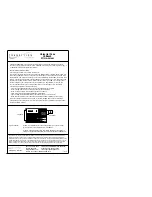
05-3946A01, Rev. C
TransNET OEM Integration Guide
G-3
Master (Station)—
The one radio transceiver in a spread spectrum network
that automatically provides synchronization information to one or more
associated remote transceivers. A radio may be programmed for either master
or remote mode using software commands.
Multiple Address System (MAS)—
See Point-Multipoint System.
Network Address—
User-selectable number between 1 and 65000 that is
used to identify a group of transceivers that form a communications network.
The master and all remotes within a given system must have the same
network address.
Point-Multipoint System—
A radio communications network or system
designed with a central control station that exchanges data with a number of
remote locations equipped with terminal equipment.
Poll—
A request for data issued from the host computer (or master PLC) to a
remote radio.
PLC—
Programmable Logic Controller. A dedicated microprocessor
configured for a specific application with discrete inputs and outputs. It can
serve as a host or as an RTU.
Remote Radio—
A radio in a spread spectrum network that communicates
with an associated master station. A radio may be programmed for either
master or remote mode using software commands.
Remote Terminal Unit—
See RTU
.
Repeater
—A radio that receives RF data and retransmits it.
See
Store-and-Forward.
RTU—
Remote Terminal Unit. A data collection device installed at a remote
radio site.
SCADA—
Supervisory Control And Data Acquisition. An overall term for
the functions commonly provided through an MAS radio system.
Standing Wave Ratio—
See SWR.
Sub-Network
—A group of transceivers and the corresponding radio that
they are directly synchronized to. A sub-network can be identified by
Extended Address.
See Store-and-Forward.
Store-and-Forward
—A radio that receives RF data and retransmits it. In the
TransNET product line, store and forward is defined as a network that
consists of vertically adjacent sub-networks that alternate communicating
upstream and downstream. The transceiver performs store and forward at the
internal data frame level (not the user data level) which allows the equipment
to stream data with minimal latency through each Extension/Repeater radio
station.
SWR—
Standing Wave Ratio. A parameter related to the ratio between
forward transmitter power and the reflected power from the antenna system.
As a general guideline, reflected power should not exceed 10% of the forward
power (
≈
2:1 SWR).









































